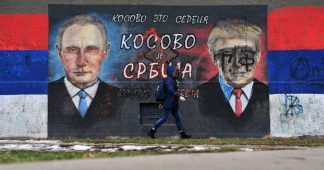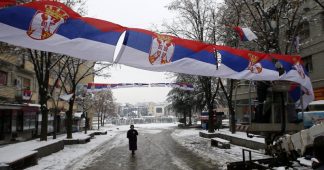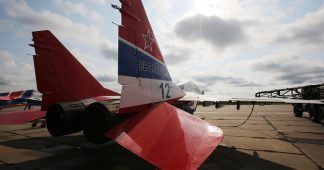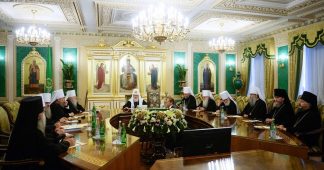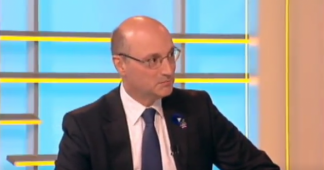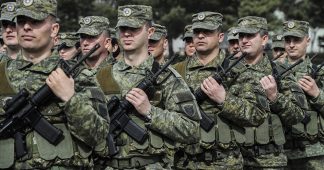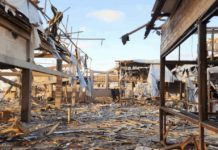18 Jan, 2019
Even before he landed, the Russian leader was given an honor guard by Serbian air force MiGs, a 2017 gift from Moscow to replace those destroyed by NATO during the 1999 air campaign that ended with the occupation of Serbia’s province of Kosovo. Russia has refused to recognize Kosovo’s US-backed declaration of independence, while the US and EU have insisted on it.
Upon landing, Putin began his first official trip of 2019 by paying respects to the Soviet soldiers who died liberating Belgrade from Nazi occupation in 1944. While most Serbians haven’t forgotten their historical brotherhood in arms with Russia, it did not hurt to remind the West just who did the bulk of the fighting against Nazi Germany back in World War II.
After official talks with Serbian President Aleksandar Vucic, Putin visited the Church of St. Sava, the grand Orthodox basilica set on the spot where the Ottoman Turks torched the remains of the first Serbian archbishop back in 1594, in an effort to maintain power.
Sava, whose brother Stefan became the “first-crowned” king of medieval Serbia, was responsible for setting up the autocephalous Serbian Orthodox Church exactly eight centuries ago this year. For all its own troubles, the Serbian Church has sided with Moscow in the current Orthodox schism over Ukraine.
Russian artisans have been working on the grand mosaic inside the basilica, and asked Putin to complete the design by placing the last three pieces, in the colors of the Russian flag.
Путин завершил мозаику Христа в Храме святого Саввы: Впечатал три мозаичных камня в цветах флага России pic.twitter.com/fCIs7ZaZcR
— Дмитрий Смирнов (@dimsmirnov175) January 17, 2019
Whether by sheer coincidence or by design, Putin also weighed in on Serbia’s culture war, giving interviews ahead of his visit to two daily newspapers that still publish in Serbian Cyrillic – while the majority of the press, whether controlled by the West or by Vucic, prefers the Latin variant imported from Croatia.
Ahead of his visit to Serbia, Vladimir Putin answered questions from Serbian media – the newspapers Politika and Večernje novosti:
?#INFtreaty
?situation in the Balkans
?ecclesiastical crisis in Ukraine➡️ https://t.co/mHvApqSuF4 pic.twitter.com/YV9VRyAdNo
— Russia in USA ?? (@RusEmbUSA) January 16, 2019
Western media usually refer to Serbia as a “Russian ally.” While this is true in a historical and cultural sense, there is no formal military alliance between Moscow and Belgrade. Serbia officially follows the policy of military neutrality, with its armed forces taking part in exercises alongside both Russian and NATO troops.
This is a major source of irritation for NATO, which seeks dominion over the entire Balkans region. Most recently, the alliance extended membership to Montenegro in 2017 without putting the question to a referendum. It is widely expected that “Northern Macedonia” would get an invitation to NATO as soon as its name change process is complete – and that was arranged by a deal both Macedonia and Greece seem to have been pressured into by Washington.
That would leave only Serbia outside the alliance – partly, anyway, since NATO has a massive military base in the disputed province of Kosovo, and basically enjoys special status in that quasi-state. Yet despite Belgrade’s repeated declarations of Serbia wanting to join the EU, Brussels and Washington have set recognition of Kosovo as the key precondition – and no Serbian leader has been able to deliver on that just yet, though Vucic has certainly tried.
Putin’s repeated condemnations of NATO’s 1999 attack, and Russian support for Serbia’s territorial integrity guaranteed by the UN Security Council Resolution 1244, have made him genuinely popular among the Serbs, more so than Vucic himself. Tens of thousands of people showed up in Belgrade to greet the Russian president.
It could be a rock gig yet it isn’t. Thousands march through Belgrade on the day of Vladimir #Putin’s visit to #Serbia, greeting the Russian President.#Belgrade pic.twitter.com/HAzueR9cCE
— Igor Zhdanov (@IgorZhdanovRT) January 17, 2019
While Vucic’s critics have alleged that many of them were bused in by the government – which may well be true, complete with signs showing both Vucic and Putin – there is no denying the strong pro-Russian sentiment in Serbia, no matter how hard Integrity Initiative operatives have tried.
The Serbs are happy to welcome Putin, even after all of Europe has been under the influence of a major campaign against Russia, which has been partly financed by UK.
The Serbs seem to be immune to propaganda against Russia.#IntegrityInitiative has failed here. ??
???? pic.twitter.com/68bJIIANnu
— Enrique⏳?? (@garoukike) January 17, 2019
One of the signs spotted in Belgrade reportedly said “one of 300 million,” referring to the old Serbian joke about there being “300 million of us – and Russians.” However, it is also a send-up of the slogan used by current street protesters against Vucic. For the past six weeks, every Saturday, thousands of people have marched through Belgrade, declaring themselves “1 of 5 million” after Vucic said he wouldn’t give in to their demands even if “five million showed up.”
The opposition Democrats accuse him of corruption, nepotism, mismanagement, cronyism – all the sins they themselves have plenty of experience with during their 12-year reign following Serbia’s color revolution. Yet they’ve had to struggle for control of the marches with the nationalists, who accuse Vucic of preparing to betray Kosovo and want “him to go away, but [Democrats] not come back.”
#Putin considers #Serbia its most trusted ally in Europe and is investing heavily in large projects, especially in the energy sector. Even though @avucic recognizes that he is receiving substantial support from Putin, he is strengthening his alliance with #Turkey as well. pic.twitter.com/9ZkZNXCcyS
— AlonBenMeir (@AlonBenMeir) January 17, 2019
There is plenty of genuine discontent in Serbia with Vucic, who first came to power in 2012 on a nationalist-populist platform but quickly began to rule as a pro-NATO liberal. It later emerged that western PR firms had a key role in his party’s “makeover” from Radicals to Progressives. Yet his subsequent balancing act between NATO and Russia has infuriated both the NGOs and politicians in Serbia beholden to Western interests, and US diplomats charged with keeping the Balkans conquered.
Washington is busy with its own troubles these days, so there was no official comment to Putin’s visit from the State Department – only a somewhat pitiful and tone-deaf tweet by Ambassador Kyle Scott, bemoaning the lack of punishment for $1 million in damages to the US Embassy during a 2008 protest against Kosovo “independence.” Yet as far as Western media outlets are concerned, why Moscow seems to be vastly more popular than Washington on the streets of Belgrade nonetheless remains a mystery.
By Nebojsa Malic
Published at https://www.rt.com/news/449079-putin-serbia-church-nato/
